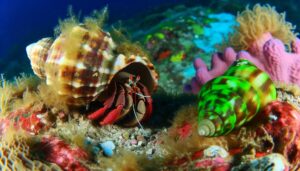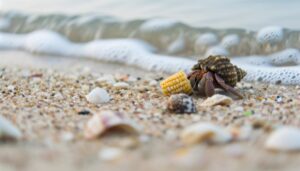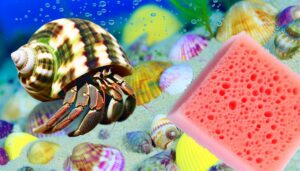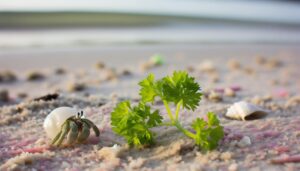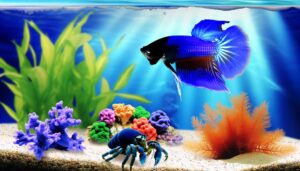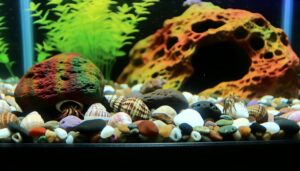What Factors Determine If Hermit Crabs Live Together?
Yes, hermit crabs can live on land. Species like Coenobita clypeatus and Coenobita compressus are adapted for terrestrial life.
They have specialized gills and a modified branchial chamber that allow them to breathe air effectively. Their limbs are optimized for movement on land, making them adept at burrowing and climbing.
Additionally, they need properly sized shells and a humid environment to keep their gills moist for respiration. These adaptations enable them to thrive outside of water, engaging in complex social behaviors within their colonies.
For more intricate details about their terrestrial adaptations and life cycle, continue exploring.
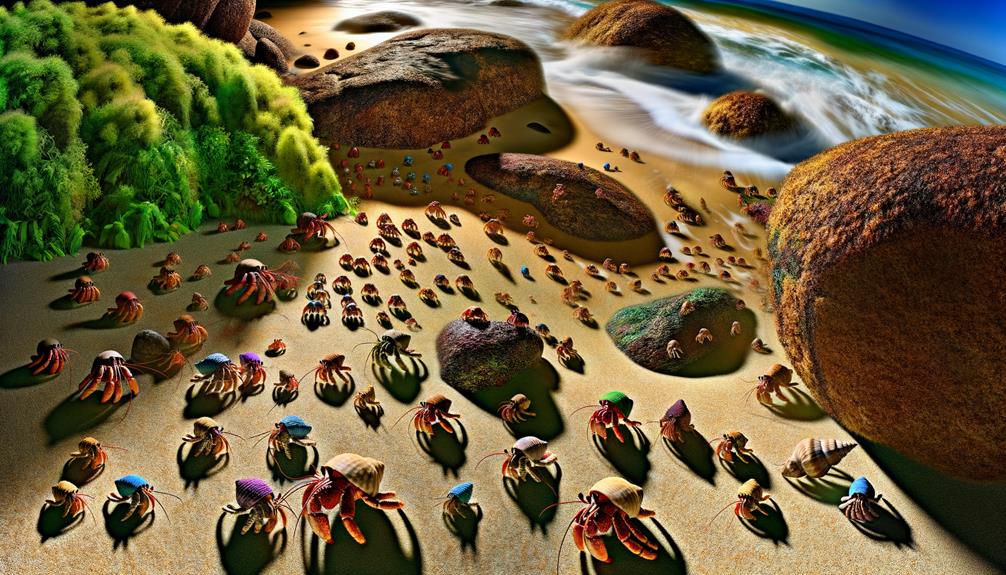
Key Takeaways
- Terrestrial species like Coenobita clypeatus and Coenobita compressus are adapted to live on land.
- Specialized gills and modified branchial chambers enable these crabs to extract oxygen from the air.
- Stronger walking legs and altered claws aid in mobility and climbing on land.
- Hermit crabs maintain humid microhabitats to keep their gills moist for breathing.
- Properly sized and shaped shells provide essential protection and reduce stress.
Hermit Crab Species
Among the myriad of hermit crab species, Coenobita clypeatus and Coenobita compressus are the most commonly found living on land, exhibiting distinct adaptations that enable their terrestrial lifestyle.
Coenobita clypeatus, often called the Caribbean hermit crab, thrives in coastal regions and is characterized by a robust exoskeleton and a preference for discarded gastropod shells.
Coenobita compressus, known as the Ecuadorian hermit crab, is distinguished by its elongated eyestalks and propensity for smaller shells.
You'll find these species actively foraging for food, maintaining humid microhabitats, and using shells for protection. Their behaviors and preferences showcase their evolutionary adaptations, providing critical insights into their survival strategies in terrestrial environments. Understanding these species aids in their conservation and care.
Adaptations for Land
You'll find that land-dwelling hermit crabs exhibit specialized adaptations to thrive outside aquatic environments.
Their gills have evolved to function efficiently in humid air, ensuring proper respiration.
Additionally, their limbs have adapted for enhanced mobility and stability on various terrestrial surfaces.
Breathing Mechanisms Explained
Terrestrial hermit crabs have evolved specialized gills and a modified branchial chamber to efficiently extract oxygen from the air. These adaptations allow them to thrive on land.
Their gills, though originally adapted for aquatic environments, have a broader surface area, enhancing oxygen absorption. The modified branchial chamber acts like a lung, maintaining moisture essential for gas exchange.
You might observe that hermit crabs keep their gills moist by frequently seeking humid environments, which is important for their respiratory efficiency. Additionally, they utilize capillary action to draw water into their gills, facilitating oxygen diffusion.
Limb Adaptations Overview
Although originally adapted for life in water, hermit crabs' limbs have undergone significant modifications to effectively navigate land environments. These adaptations enable them to support their ecosystems and thrive on solid ground. Their legs have become more sturdy, providing better stability and movement on uneven surfaces. Additionally, claws have developed for burrowing and climbing, crucial for finding shelter and food.
| Limb Type | Adaptation Description |
|---|---|
| Walking Legs | Become stronger for improved land movement |
| Claws | Altered for burrowing and climbing |
| Sensory Antennae | Enhanced to detect environmental signals |
| Pereiopods | Adjusted for carrying heavier shells |
| Maxillipeds | Developed to aid in handling food on land |
These detailed adaptations illustrate the hermit crabs' impressive ability to shift from water to land life efficiently.
Respiratory System
You'll notice that hermit crabs have developed modified gills, which are adapted for extracting oxygen from air rather than water.
These specialized gills require a high degree of moisture retention, facilitated by a unique mechanism involving their exoskeleton and behavior.
Modified Gills Function
Hermit crabs on land have evolved modified gills that allow them to efficiently extract oxygen from the air, a critical adaptation for their terrestrial lifestyle. These gills are uniquely structured to facilitate gas exchange in an aerial environment.
Unlike their aquatic counterparts, land hermit crabs possess gill filaments that are more rigid and feature a higher surface area, optimizing oxygen absorption. Their gills are also located in a chamber that can trap moist air, ensuring the gills don't dry out.
This specialized respiratory system demonstrates a remarkable evolutionary shift, allowing hermit crabs to thrive outside aquatic habitats. Understanding these adaptations helps you better appreciate the intricate balance required for these creatures' survival and informs proper care practices.
Moisture Retention Mechanism
Building on their specialized gills, land hermit crabs employ a sophisticated moisture retention mechanism within their respiratory system to prevent desiccation and maintain efficient gas exchange. You'll find their gills are adapted to extract oxygen from air, yet they require constant moisture for peak function.
Hermit crabs secrete a thin layer of mucus over their gills, which traps moisture and facilitates oxygen absorption. They also possess modified branchiostegal lungs, intricate structures that further enhance gas exchange while minimizing water loss.
Shell Requirements
Ensuring that land-dwelling hermit crabs have access to appropriately sized and shaped shells is vital for their development, protection, and overall well-being. You'll need to provide a variety of shells to accommodate their growth and preferences.
Research indicates that improper shell fit can lead to stress and increased vulnerability to predators.
Consider the following when selecting shells for your hermit crabs:
- Size: Shells should be slightly larger than the crab's current shell to allow for growth.
- Shape: Offer various shapes to suit different preferences, such as round or elongated openings.
- Material: Natural, unpainted shells are essential to avoid toxic chemicals that can harm the crabs.
Habitat Setup
To create an ideal habitat for your land-dwelling hermit crabs, you'll need to make certain the enclosure maintains proper humidity levels, temperature, and substrate depth. Aim for a humidity level of 70-80%, which you can achieve using a hygrometer and regular misting. Temperature should be kept between 75-85°F, monitored with a reliable thermometer.
Use a substrate mix of sand and coconut fiber at least 6 inches deep to allow for proper burrowing. Provide a variety of hiding spots with natural materials like driftwood and non-toxic plants. Guarantee the enclosure is escape-proof yet well-ventilated.
A shallow dish of dechlorinated water is essential for hydration. By adhering to these guidelines, you'll create a thriving environment for your hermit crabs.
Diet and Nutrition
Proper nutrition is crucial for land-dwelling hermit crabs, needing a balanced diet of protein, calcium, and other essential nutrients to support their growth and exoskeleton health. You should prioritize offering a diverse range of foods to meet these needs.
High-quality protein sources include:
- Animal-based proteins: Cooked chicken, fish, and eggs provide the necessary amino acids.
- Calcium-rich foods: Crushed eggshells, cuttlebone, and calcium-fortified commercial hermit crab diets aid in exoskeleton maintenance.
- Fresh fruits and vegetables: Apples, carrots, and leafy greens supply important vitamins and minerals.
A varied diet ensures thorough nutritional support, promoting excellent health and longevity. Regularly monitor and adjust their feeding regimen to align with observed dietary preferences and health indicators.
Hydration Needs
Maintaining appropriate hydration levels is essential for land-dwelling hermit crabs. They depend on both fresh and saltwater sources to regulate their internal water balance and support their respiratory system. You must provide separate dishes for each type of water. Make sure they're shallow enough to prevent drowning but deep enough for submersion.
Hermit crabs absorb water through their gills and the thin membranes on their abdomens. This means they must have constant access to these water sources. Regularly check the water quality, as contaminants can harm their delicate systems. Use dechlorinated water for freshwater needs and mix marine salt with dechlorinated water for saltwater.
This careful attention ensures their hydration needs are met and promotes their overall well-being.
Social Behavior
You'll observe that hermit crabs exhibit complex social behaviors, often forming colonies that can number in the hundreds.
They communicate through a combination of antennae movements, chirps, and shell rapping to relay information about threats and resources.
Additionally, hermit crabs establish social hierarchies based on shell size and strength, influencing their access to resources and mating opportunities.
Colony Living Patterns
Land-dwelling hermit crabs exhibit complex colony living patterns characterized by intricate social behaviors such as shell exchanges, hierarchical structures, and cooperative foraging. These behaviors ensure their survival and well-being in terrestrial environments.
For instance, shell exchanges involve a series of negotiations where crabs inspect and swap shells to find optimal protection.
Hierarchical structures maintain order within the colony, with dominant crabs often securing the best resources.
Cooperative foraging allows them to efficiently locate food sources, benefiting the entire group.
You'll observe:
- Shell exchanges: A meticulous process of evaluation and negotiation.
- Hierarchical structures: Clearly defined social ranks.
- Cooperative foraging: Collective efforts to locate and procure food.
Understanding these patterns can inform better habitat management and care practices for land-dwelling hermit crabs.
Communication Among Hermit Crabs
Communication among hermit crabs, essential for their social interactions, involves a sophisticated array of tactile, visual, and chemical signals.
You'll often observe hermit crabs using their antennae for tactile communication, tapping and stroking to convey information or establish contact.
Visual signals, including body postures and the movement of limbs, play a significant role during encounters with other crabs.
Chemical communication, mediated through pheromones, allows them to detect the presence of conspecifics and assess potential mates or rivals.
These intricate communication methods are vital for maintaining social cohesion and coordinating group activities.
Understanding these behaviors helps you appreciate the complex social dynamics of hermit crabs and aids in creating environments that support their well-being and natural behaviors.
Social Hierarchies Formation
Hermit crabs establish social hierarchies through competitive interactions, often engaging in physical contests and shell exchanges to assert dominance. These interactions are critical for maintaining order and survival within their communities. You'll observe that dominant crabs often have better access to resources and prime shell choices.
Hierarchies are formed through:
- Aggressive displays: Hermit crabs use their claws and body postures to intimidate rivals.
- Shell rapping: A behavior where crabs knock on each other's shells to determine strength and resolve.
- Shell exchanges: Switching shells with other crabs, often through coercion or negotiation.
Molting Process
During the molting process, a land-dwelling hermit crab will shed its exoskeleton to facilitate growth and repair. This phase is crucial for the crab's development and involves several stages.
Initially, the crab absorbs water to swell its body, causing the old exoskeleton to crack. It then meticulously extracts itself, starting with the legs and claws. Once free, the crab consumes parts of its old exoskeleton to reclaim essential calcium and other nutrients.
You should make sure the crab is in a safe, moist environment during molting, as it remains vulnerable until the new exoskeleton hardens. Providing a shallow dish of water and a secluded space can greatly enhance its molting success and overall well-being.
Common Health Issues
Land-dwelling hermit crabs often face several common health issues, including shell rot, mites, and dehydration, each of which requires specific preventative and remedial measures.
Shell rot, characterized by discolored or pitted shells, results from bacterial or fungal infections. Regularly cleaning and drying their shells can prevent this condition.
Mites, tiny parasitic arachnids, infest hermit crabs, causing irritation and stress. You can control mites by isolating affected crabs and maintaining a clean habitat.
Dehydration, indicated by lethargy and sunken eyes, occurs when humidity levels are insufficient.
Consistent monitoring and appropriate habitat management can greatly enhance your hermit crab's well-being.
Conclusion
To sum up, understanding hermit crabs' distinct adjustments is essential for their survival on land.
You'll have to make sure they've the appropriate shells, which function like a knight's armor, shielding them from environmental dangers.
Adequate habitat arrangement, hydration, and consideration of social interactions are necessary for their health.
By meeting these requirements, you can avoid typical health problems and aid their molting process.
With this knowledge, you're well-prepared to establish a flourishing habitat for your land-dwelling hermit crabs.

